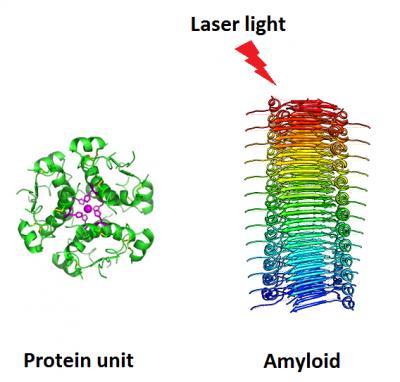In what may very well prove to be a landmark discovery, researchers at Chalmers University of Technology (Sweden) and the Polish Wroclaw University of Technology (Poland) have proven phototherapy to be a more effective means of treating diseases such as Alzheimer’s, Parkinson’s, and Mad Cow, then the current method, which involves chemicals.

Specifically, the group discovered that it is possible to distinguish aggregations of proteins — which are believed to be the root of all these diseases — from well-functioning proteins by using their multiphoton laser technique.

To give you a visual of what doctors are looking for when treating these diseases, in the image above, a properly functioning protein can be seen on the left-hand side. When a high-power laser light is used, it is optically invisible. A toxic amyloid, responsible for the aforementioned diseases, is located to its right.
The problem doctors have constantly run into when treating these diseases is being able to locate and remove all of the proteins to the right, without hurting the proteins to the left. Currently, doctors use chemicals for both the detection and removal process; as one can imagine, these chemicals are highly toxic and harmful to those being treated.
The group believes that photoacoustic therapy, which is already used for tomography, can be used in to locate and destroy malfunctioning proteins. If successful, chemical treatment would not be necessary, nor would surgery.
“Nobody has talked about using only light to treat these diseases until now. This is a totally new approach and we believe that this might become a breakthrough in the research of diseases such as Alzheimer's, Parkinson's and Creutzfeldt-Jakob disease (Mad Cow). We have found a totally new way of discovering these structures using just laser light”, says Piotr Hanczyc at Chalmers University of Technology.
Story via: eurekalert.org
Advertisement
Learn more about Electronic Products Magazine





